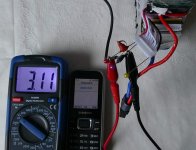kdog
10 kW
15mins to 3.2 then 80mins to 3.5 is a positive sign... Fingers crossed.
kdog said:15mins to 3.2 then 80mins to 3.5 is a positive sign... Fingers crossed.

999zip999 said:I like rc stlye bullet connectors cheap and good.
999zip999 said:Be careful with the charging pins if to close use a piece of plastic to separate. Like plastic bottle. L shape self standing.
kdog said:15mins to 3.2 then 80mins to 3.5 is a positive sign... Fingers crossed.
999zip999 said:Would be good to check cell voltage 1- 10 . As 41.5v cold mean one at 3.59 and one at 4.99v or something. I just have know? Then button it up.
Hillhater said:Great news !...pat yourself on the back for working logically through this.
Hillhater said:Cycle it a few times to check LVC, HVC etc is all working well before you totally seal it back up.
Hillhater said:There are several threads on ways to discharge a pack.
https://endless-sphere.com/forums/viewtopic.php?f=14&t=90437&p=1318152&hilit=discharge+load#p1318152
daisy chained halogen lamps (3 ,x 50W in series) , are common, or an old toaster/heater element etc..
I found 100w , 24 v lamps in an Ebay store for <$1 each.
